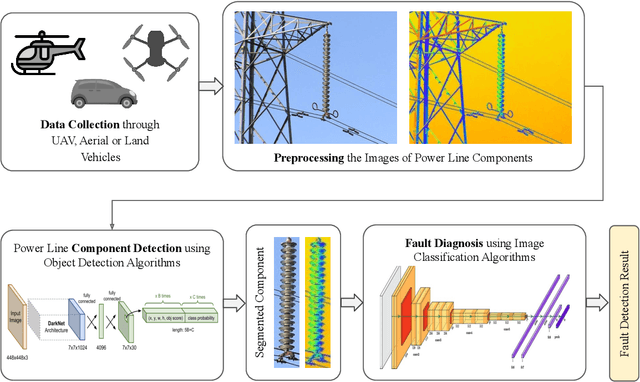Javier Hernandez Fernandez
Deep Learning in Automated Power Line Inspection: A Review
Feb 10, 2025



Abstract:In recent years, power line maintenance has seen a paradigm shift by moving towards computer vision-powered automated inspection. The utilization of an extensive collection of videos and images has become essential for maintaining the reliability, safety, and sustainability of electricity transmission. A significant focus on applying deep learning techniques for enhancing power line inspection processes has been observed in recent research. A comprehensive review of existing studies has been conducted in this paper, to aid researchers and industries in developing improved deep learning-based systems for analyzing power line data. The conventional steps of data analysis in power line inspections have been examined, and the body of current research has been systematically categorized into two main areas: the detection of components and the diagnosis of faults. A detailed summary of the diverse methods and techniques employed in these areas has been encapsulated, providing insights into their functionality and use cases. Special attention has been given to the exploration of deep learning-based methodologies for the analysis of power line inspection data, with an exposition of their fundamental principles and practical applications. Moreover, a vision for future research directions has been outlined, highlighting the need for advancements such as edge-cloud collaboration, and multi-modal analysis among others. Thus, this paper serves as a comprehensive resource for researchers delving into deep learning for power line analysis, illuminating the extent of current knowledge and the potential areas for future investigation.
Inferring Power Grid Information with Power Line Communications: Review and Insights
Aug 21, 2023Abstract:High-frequency signals were widely studied in the last decade to identify grid and channel conditions in PLNs. PLMs operating on the grid's physical layer are capable of transmitting such signals to infer information about the grid. Hence, PLC is a suitable communication technology for SG applications, especially suited for grid monitoring and surveillance. In this paper, we provide several contributions: 1) a classification of PLC-based applications; 2) a taxonomy of the related methodologies; 3) a review of the literature in the area of PLC Grid Information Inference (GII); and, insights that can be leveraged to further advance the field. We found research contributions addressing PLMs for three main PLC-GII applications: topology inference, anomaly detection, and physical layer key generation. In addition, various PLC-GII measurement, processing, and analysis approaches were found to provide distinctive features in measurement resolution, computation complexity, and analysis accuracy. We utilize the outcome of our review to shed light on the current limitations of the research contributions and suggest future research directions in this field.
 Add to Chrome
Add to Chrome Add to Firefox
Add to Firefox Add to Edge
Add to Edge